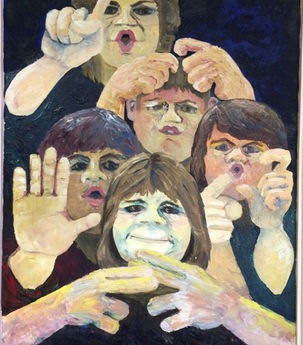EXHIBIT:
DE'VIA
DE'VIA
Availability:
Ongoing
Deaf View/Image Art, also known as De’VIA, is art that examines and expresses the Deaf Experience from a cultural, linguistic, and intersectional point of view.
The 4 Elements of De’VIA:
De Deaf & Deaf-Blind Expression of Affirmation, Resistance, and Liberation
V View of how Deaf & Deaf-Blind experience the world
I Images/Motifs/Symbols of the Deaf Experience
A Art, Activism, Aesthetics, and Authentic Expressions of the Deaf Experience
De’VIA History
Deaf people often are naturally drawn to art as a visual means of communication. Despite the storied history of Deaf Artist, it was not until 1989 that a term was coined for this genre: Deaf View/Image Art, or De’VIA. In 1989, Paul Johnson and Betty G. Miller formed a four day workshop for Deaf artists to explore works about the Deaf perspective. Nine visual artists came together: painter Chuck Baird, art historian Deborah (Sonnenstrahl) Blumenson, fiber artist Nancy Creighton, video artist Lai-Yok Ho, Fiber artist Sandi Inches-Vasnick, sculptor Paul Johnson, painter Betty Miller, painter Alex Wilhite and sculptor Guy Wonder. It was at this gathering that they devised the term De’VIA (sign: DEAF-look-at-palm-ART). French in appearance as a nod to Laurent Clerc and ASL’s French origins, they created a manifesto that described De’VIA and a mural to accompany it. The group’s historical work was unveiled at the international Deaf Way Festival that following summer.







